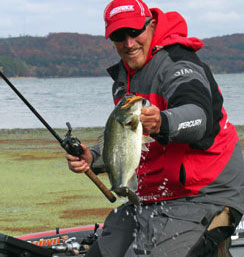The Finer Points of Punching Mats
 Two bass fishing tactics are commonly used to pull big bass from massive grass mats: Throwing a frog for those fish willing to smash through the “roof,” and punching through the grass for those holding below. If bass aren’t hitting the top, the choice is already made. Put up your dukes and start punchin’.
Two bass fishing tactics are commonly used to pull big bass from massive grass mats: Throwing a frog for those fish willing to smash through the “roof,” and punching through the grass for those holding below. If bass aren’t hitting the top, the choice is already made. Put up your dukes and start punchin’.
Endless grass mats make it seem like Elite pro Terry Scroggins is searching for a needle in haystack. With each pitch, Scroggins’ big weight hits the dense mat, punches a hole and pulls his Big Show Craw down beneath the grass.
He lifts the bait a time or two to see if anyone is home, pulls the bait back out of the same hole and then pitches to another spot. The approach appears random, but Scroggins is highly intentional about his lure choice, the spots where he flips and each presentation.
Guide Jimmy Mason also relies heavily on grass-punching strategies. Mason guides mostly on lakes Pickwick and Guntersville, both of which support extensive stands of matted vegetation.
Punching is a prime technique anywhere vegetation stays matted on top, and is normally most effective on sunny days when bass seek shade.
Findin’ and Fishin’ Em
Finding bass in mats is a lot like locating them in other cover – look for something different.
“Look at the grass mat just like you‘d look at a shoreline,” Scroggins said. “Look for the little points and pockets, greener spots, mixes of grass types and other cover poking through. Anything that’s different can hold fish.”
Not all distinctions are visible from above the surface, but topo maps or GPS maps/graphs reveal bottom breaklines, ditches, points and other features that may hold fish.
Mason typically approaches mats of grass methodically, beginning along outside edges and then moving to scattered mats and eventually into the thickest stuff. He watches and listens continually for movement beneath the mats that suggests feeding fish, and pays careful attention to every detail every time a fish strikes.
Because mats commonly cover extensive areas, it’s critical to refine the pattern as a day progresses. Move quickly and make a lot of punches at a variety of locations until a fish hits, then slow down. Bass commonly congregate under mats, so an area that yields one bass often holds more. When one strikes, make your next pitch to that exact spot.
Mason says that a lot of his clients who are unfamiliar with punching mats miss fish all day long the first time. Detecting strikes can be tough.
“First, make sure your bait goes all the way through the mat,” he said. “When it does, let it fall to the bottom. Pay attention because aggressive fish might grab it before gets to the bottom.”
Once the bait finds bottom, both anglers advise experimenting to determine where the fish are holding in the water column. Mason hops the lure a time or two, then lifts it almost to the surface and smacks it against the top of the mat a few times before dropping it again.
“They might be on the bottom,” he said, “but they also might be barely under that mat. When that’s the case, smacking the mat with the bait triggers strikes.”
Best Baits
Likely forage under a mat is a critical factor for Scroggins when he’s trying to decide which bait to punch. In Florida, crawfish abound beneath many mats, so his bait of choice often is his namesake Big Show Craw.
Where bluegills are the main forage he’s more likely to use a YUM 2ube or Vibra King Tube. A compact creature-type plastic like the Wooly Bug is a blend of the two styles, and he often tries it first when he’s not certain of the preferred forage.
 The size of the bass present also influences lure choice. When Mason is targeting heavyweight bass he prefers the Vibra King Tube. “I don’t know exactly what it is about that Vibra King Tube,” he said, “but it attracts big fish.”
The size of the bass present also influences lure choice. When Mason is targeting heavyweight bass he prefers the Vibra King Tube. “I don’t know exactly what it is about that Vibra King Tube,” he said, “but it attracts big fish.”
Both like dark colors for punching. The grass roof cuts light penetration so bass can’t see baits well, and dark-colored baits provide a better silhouette. Go-to colors are green pumpkin and black/blue.
Other requirements for punching bass are a heavy sinker (1.5-ounce, often pegged), strong straight-shank or offset worm hook, heavy flippin’ rod and 60- to 80-pound braid.
Category: Fishing Tips/Techniques





